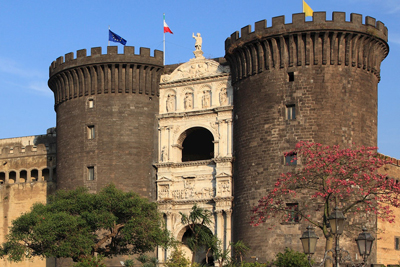
Located in front of Piazza Municipio and the city hall, Palazzo San Giacomo, in central Naples, the imposing medieval Castel Nuovo was built in 1282 by Charles I of Anjou, who after taking over Naples and the Swabians' Sicilian kingdom, decided to base the new dynasty in Naples, rather than Palermo in Sicily. As he found himself in control not only of his new southern Italian acquisitions but also of possessions in Tuscany, northern Italy, and Provence (France), he upgraded the status of Naples as the capital of the Kingdom of Sicily and Naples and launched the ambitious project of constructing the Castel Nuovo as a royal seat for the kings of Naples, and expanding the port and city walls.
The construction of the fortified castle started in 1279, under the French architect Pierre de Chaulnes, and completed just three years later, which is a very short time considering its massive size and the available techniques of construction of the period. However, the new palace remained unused until the death of Charles I in 1285, when the new King Charles II of Naples moved with his family and the court to the new residence, which he enlarged and embellished aesthetically. Nevertheless, it was extensively renovated and extended in 1309 by Robert, the king of Naples, and Castel Nuovo became a centre of culture as it hosted important personalities of the culture of the time, such as the writers Petrarch and Giovanni Boccaccio, while the most famous painters of the time, like Montano d’Arezzo, Giotto, and Pietro Cavallini painted the Palatine Chapel in 1332.

The imposing single-sided white marble triumphal arch that stands between the two western Towers of the Angevin Castle was built in 1470, to commemorate the triumphal entry of Alfonso V of Aragon, later Alfonso I, King of Naples and Sicily, to Naples on 26 February 1443. The 35 metres tall two-storey triumphal arch with two stacked arches serves both as the frontispiece and the entrance to the castle.

Although the triumphal arch in Castel Nuovo is single-faced, it is said that it was originally planned to construct a free-standing arch for the Piazza del Duomo with two faces. But as the house of a favourite officer in service of King Alfonso was due to be razed to make room for the monument, the plan was abandoned, and the site of the arch was shifted to the Castel Nuovo. Enriched with sculptured decorations, the triumphal arch in Castel Nuovo is a splendid example of Late Gothic and early Renaissance architecture.
While the overall design had been attributed to Pietro di Martino of Milano, who was also responsible for several of the reliefs, some modern scholars attribute the design to Francesco Laurana, one of the more significant and complex sculptors of the 15th century.

Flanked by Corinthian columns, the monument comprises four superimposed zones, including two distinct arches, which belong to separate periods. The sculptured decorations were executed by several sculptors that included Isaia da Pisa, Paolo Romano, Domenico Gagini, Andrea Florentino, and many others. While the first level sculpture depicts a triumphal Quadriga, a chariot drawn by four horses, leading Alfonso parading, the second upper arch is surmounted by Lions and four niches with statues depicting the virtues of Alfonso.
The rounded lintel on the top has two genii with horns of plenty surmounted by Alfonso in the attire of a warrior, and the centre of the monument contains a shield with the symbols of Aragon. Apart from that, there are three statues of St Michael, St Anthony the Abbot, and St Sebastian, and the two recumbent ones, on the summit of the arch, created by Giovanni da Nola. The triumphal arch of the Castel Nuovo leads to the piazza by the Bronze Gates, executed by the monk Guglielmo of Naples.